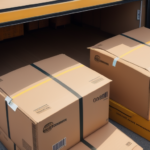What You Need to Know About Standard Shipping
As an e-commerce business owner, shipping is an integral part of your success. Without reliable and efficient shipping, you can't get your products to your buyers within the expected time frame. In this article, we will explore everything you need to know about standard shipping, also known as ground shipping, including its basics, types, pros and cons, costs, delivery times, comparisons with other shipping options, tips for selecting the right provider, tracking orders and deliveries, common issues and solutions, packaging and labeling goods, managing returns and refunds, and trends and predictions for the future.
The Fundamentals of Standard Shipping
What is Standard Shipping?
Standard shipping refers to the most affordable shipping method offered by most carriers. It typically takes longer than expedited options but comes at a lower cost. This method involves transporting your package via ground transportation, usually by truck or train, making it ideal for non-urgent products and large, heavy items that require economy shipping.
Environmental Impact
One of the advantages of standard shipping is its potential environmental benefits. Ground transportation generally produces fewer carbon emissions compared to air or sea transportation. According to the Environmental Protection Agency (EPA), reducing carbon emissions is crucial for mitigating climate change, making standard shipping a more eco-friendly option for conscious consumers.
Delivery Time Variability
Delivery times for standard shipping can vary depending on the carrier and the destination. While it is generally reliable, unforeseen factors such as weather conditions or logistical issues can cause delays. It's important to plan accordingly and allow for extra time when choosing this shipping method to ensure timely deliveries.
Types of Shipping Methods
Standard Shipping
The most cost-effective option, suitable for non-urgent and bulkier items.
Expedited Shipping
Offers faster delivery times, typically at a higher cost. Ideal for customers who need products quickly.
International Shipping
Enables shipping outside your home country, expanding your customer base globally. This method may involve additional paperwork and customs fees.
Specialty Shipping
Designed for highly fragile or sensitive products, requiring extra packaging and handling to ensure safe delivery.
Pros and Cons of Standard Shipping
Advantages
- Affordability: Usually the cheapest shipping option available.
- Cost-Effective for Heavy Items: Ideal for large and bulky products.
- Eco-Friendly: Lower carbon emissions compared to air shipping.
Disadvantages
- Longer Delivery Times: Not suitable for time-sensitive products.
- Potential Reliability Issues: Higher chance of delays or damages.
- Limited Tracking and Insurance: May require additional fees for these services.
Calculating Shipping Costs and Delivery Times
Factors Influencing Costs
- Weight and Dimensions: Heavier and larger packages cost more to ship.
- Distance: Longer distances increase shipping costs.
- Carrier Rates: Different carriers have varying pricing structures.
Using Online Calculators
Most shipping carriers offer online calculators to estimate costs and delivery times. By inputting your package details, you can compare rates and choose the best option for your needs.
Cost-Saving Tips
- Negotiate Rates: Many carriers offer discounts for high shipping volumes.
- Optimize Packaging: Use lightweight and sturdy materials to reduce weight and size.
- Choose the Right Carrier: Research carriers to find the most cost-effective and reliable options.
Comparing Standard Shipping with Other Options
Standard vs. Expedited Shipping
Standard shipping is slower but more affordable compared to expedited shipping, which offers faster delivery at a higher cost.
Standard vs. International Shipping
While standard shipping is less expensive, international shipping allows you to reach a global audience but may involve additional fees and longer delivery times.
Standard vs. Specialty Shipping
Specialty shipping is designed for fragile or sensitive items, offering extra protection at a higher cost compared to standard shipping.
Choosing the Right Shipping Provider
Research Carriers
Start by researching various shipping carriers and reading customer reviews to assess their reliability, delivery times, customer service, and pricing structures.
Consider Integration
Ensure the carrier is compatible with your e-commerce platform. Look for providers that offer seamless integration to streamline your shipping processes.
Evaluate International Capabilities
If you plan to expand globally, choose a carrier with robust international shipping services and experience in handling customs clearance.
Negotiate Rates
Don't hesitate to negotiate rates based on your shipping volume or specific needs. Many carriers are open to offering discounts for loyal or high-volume customers.
Tracking Orders and Deliveries
Utilizing Carrier Tracking Services
Most carriers offer online tracking services that allow you to monitor the status of your packages from pickup to delivery. This provides real-time updates and helps manage customer expectations.
Customer Communication
Provide customers with tracking numbers and carrier information. Transparent communication builds trust and enhances the customer experience.
Handling Delivery Issues
Establish clear policies for handling lost or damaged packages, incorrect addresses, and unsuccessful delivery attempts. Communicate these policies to customers to manage expectations and provide solutions.
Common Shipping Issues and Solutions
Lost or Damaged Packages
Ensure you have insurance coverage for shipped items. Double-check addresses and packaging to minimize the risk of damage.
Delayed Deliveries
Choose carriers with reliable delivery records and consider diversifying your shipping methods to mitigate the impact of delays.
Incorrect Addresses
Implement address verification tools to reduce the chances of shipping to incorrect locations.
Weather-Related Delays
Stay informed about weather conditions and communicate proactively with customers if delays are expected.
Optimizing Your E-commerce Site for Standard Shipping
Clear Shipping Policies
Provide detailed and transparent shipping policies, including estimated delivery times and available shipping options.
Easy Shipping Selection
Ensure customers can easily select their preferred shipping method during checkout, enhancing the user experience.
Leverage Analytics
Use analytics tools to track key metrics such as conversion rates, cart abandonment, and shipping times. Analyze this data to identify and address areas for improvement.
Packaging and Labeling Best Practices
Quality Packaging Materials
Use high-quality packaging that protects products from impact, moisture, and temperature fluctuations.
Accurate Labeling
Ensure all packages are labeled clearly and accurately to prevent delays and misdeliveries. Use standard labeling practices and include all necessary shipping information.
Eco-Friendly Options
Consider using sustainable packaging materials to appeal to eco-conscious customers and reduce environmental impact.
Managing Returns and Refunds
Clear Return Policies
Establish and communicate clear return policies, including instructions on how customers can initiate returns.
Align with Carrier Policies
Ensure your refund policies are consistent with your carrier's policies to provide a smooth return process.
Provide Return Shipping Labels
Offering pre-paid return shipping labels simplifies the return process for customers, enhancing their overall experience.
The Future of Standard Shipping: Trends and Predictions
Automation and Robotics
The shipping industry is increasingly adopting automation and robotics to improve efficiency and reduce costs. This trend is expected to continue as technology advances.
Growth of E-commerce
The rise of e-commerce is driving demand for more efficient and faster shipping solutions. Carriers are developing new methods to meet these evolving needs.
Sustainability Initiatives
There is a growing focus on sustainability within the shipping industry. Expect to see more eco-friendly shipping options and practices in the future.
Conclusion: Enhancing Your Standard Shipping Strategy
Standard shipping is a crucial component of any e-commerce business's success. By understanding its fundamentals, evaluating different shipping methods, calculating costs effectively, choosing the right provider, tracking orders diligently, addressing common issues, optimizing your website, adhering to packaging best practices, managing returns efficiently, and staying informed about industry trends, you can maximize the benefits of your standard shipping strategy. This approach ensures the safe and timely delivery of your products, leading to satisfied customers and sustained business growth.




















